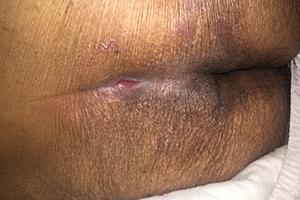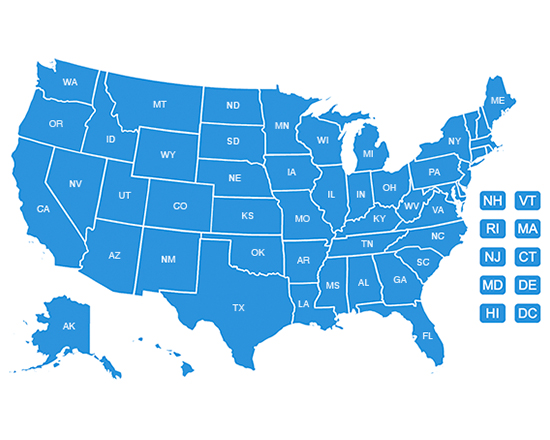The Nursing Home Law Center is committed to providing the legal resources necessary to hold negligent facilities accountable.
Stage 1 Pressure Ulcer

Pressure ulcers occur when people spend long periods in one position, whether lying in bed or sitting in a wheelchair. Continuous pressure on one area restricts blood flow and damages the tissue, causing skin cells to lose oxygen. As a result, the cells die and break down, forming a pressure sore.
This article will define and explain stage one pressure ulcers, their causes, prevention and treatment options, and legal avenues for nursing home residents who have suffered a pressure injury.
Understanding Stage 1 Pressure Ulcers
Caretakers and healthcare providers use four stages of pressure injuries to determine treatment. Noticing pressure wounds in the mildest stage makes them easier to treat and reduces the risk of infection. This is how a decubitus ulcer starts.
Non-Blanchable Redness
Visible blanching is a sign of healthy skin, meaning that after you press it for a few seconds, it temporarily becomes white. With a stage one pressure ulcer, the skin looks red even after pressing it, typically called non-blanchable redness.
Also, the skin surface is still intact — unlike with more severe pressure ulcers, where the skin breaks down, forming an open wound.
Skin color reveals whether the pressure sore is stage one or if the situation is more severe. In stage one ulcers, the skin is reddish or pink, meaning it is still viable (alive).
In unstageable sores (those outside the main stages), the sore is covered in dead skin, which can be yellow, tan, or grayish. Discolored skin can point to a deep tissue injury, with intact skin but dead tissue underneath. Similarly, a blood-filled blister indicates a more severe pressure sore, even though the skin appears intact.
Skin Temperature
In a stage one pressure ulcer, the skin may feel warmer or cooler than the surrounding areas due to changes in blood flow.
Increased warmth often indicates inflammation as the body directs blood to the damaged site in response to pressure. In contrast, cooler skin may suggest reduced blood circulation, which can occur when sustained pressure restricts blood flow.
Tissue Consistency
In stage one decubitus ulcers, the affected area may feel firmer or softer than the surrounding area, depending on the body’s response to the pressure.
Firmness can result from swelling or tissue hardening as the skin and underlying structures react to stress. Conversely, softness may indicate tissue damage and fluid accumulation. In both cases, the caretaker must respond with appropriate treatment and prevention measures.
Causes of Stage 1 Pressure Sores
People with circulation problems who are immobilized and incontinent are at a higher risk of developing pressure sores. These are common risk factors for this painful injury.
Immobility
Prolonged immobility restricts blood supply to areas under constant pressure, especially bony areas such as hips, heels, shoulder blades, the back of the head, and tailbone. The lack of oxygen and nutrients leads to tissue damage and, over time, cell death. As the wound worsens, it results in dead tissue.
Caretakers must change the positions of immobilized patients regularly to distribute pressure, improve circulation, and reduce the risk of pressure sores.
Friction and Shear
Friction and shear forces are major culprits for this type of skin injury.
Friction happens when parts of your body rub against a surface, such as when people are moved in bed or a wheelchair without proper lifting. Over time, this weakens the skin, making it more prone to damage.
Shear is a bit different — it occurs when skin layers are pulled in opposite directions, often from sliding down in bed. This stretching effect can cause deep tissue layers to tear and disrupt blood circulation. This often leads to a deep tissue injury. Doctors must develop a new care plan for a suspected deep tissue injury to prevent infections and complications.
Poor Nutrition and Hydration
Poor nutrition and hydration can increase the risk of bed sores and prevent wound healing. When the body lacks nutrients and adequate calories, it struggles to repair tissue damage. Similarly, dehydration causes the skin to lose elasticity, making it more likely to tear under pressure.
Adequate nutrition and hydration are not only important for prevention, but they help the affected person heal more quickly if bedsores occur.
Incontinence
Incontinence is one of the main risk factors for pressure injury development. Frequent exposure to moisture from urine or feces can weaken the skin and make it soft and fragile.
Combined with friction and increased pressure, fragile skin becomes more prone to breakdown, ulcers, and infection.
Preventing and Treating Pressure Sores
Treatment focuses on promoting wound healing and responding to the first signs of infection, but it must also be combined with prevention. Otherwise, existing pressure sores will not heal, and new ones may develop. Unhealed pressure sores can turn into stage IV wounds, which often come with life-threatening complications.
Regular Skin Inspections
Frequent skin checks allow caretakers to notice new pressure injuries and monitor existing ones. Caretakers should check for redness, temperature changes, and changes in texture. This is especially important for residents with darker skin tones because redness may be less apparent.
It’s also important to listen to residents, as stage one pressure sores may itch or hurt.
Pressure Relief Techniques
Caretakers use several techniques to remove pressure from affected or at-risk areas:
- Cushions – Air, gel, or foam cushions are used to relieve pressure as added cushioning redistributes pressure. Foam dressings can also help ease the pressure.
- Pressure-relieving mattresses – Airflow mattresses use air-filled cells that inflate and deflate in cycles to redistribute pressure evenly across the body. This ensures no area of the body is under constant pressure.
- Repositioning – Caretakers should move patients regularly according to their care plan. High-risk patients, such as those with health conditions like diabetes, should be changing positions more often.
Adequate Nutrition and Hydration
Proper nutrition and hydration help prevent pressure sores and heal existing ones. A balanced diet rich in protein, vitamins, and minerals strengthens the skin, maintains muscle, and contributes to collagen production.
Hydration is equally important. Well-hydrated skin is less likely to tear and may recover more quickly from existing damage. Pressure injuries can be a sign of neglect in nursing homes, and they are often paired with malnutrition and poor hydration, so residents should be checked for signs such as weight loss and concentrated urine.
Skin Care
Good skin hygiene and regular moisturizing promote healing and prevent new injuries from occurring. The caretaker should wash the area with mild soap and water and consider a moisture barrier for incontinent patients. This removes irritants such as sweat or urine and reduces infection risk.
If the home is understaffed, the nurses may not have enough time to properly care for each patient. If you notice bed sores on someone you care about, check for signs of poor hygiene, such as dirty clothes, long fingernails, or unwashed hair.
Legal Options for Victims of Nursing Home Abuse
If left untreated, pressure sores can worsen quickly, increasing the risk for life-threatening infections. This is why it’s important to react if you or a loved one develops a pressure sore, regardless of its stage.
Negligence and Malpractice
Stage one pressure ulcers can be considered evidence of negligence or malpractice by nursing home staff if they result from inadequate care or disregard for protocols.
Nursing home staff have a legal duty of care for each resident, including:
- Regular skin assessment
- Repositioning and pressure-relieving techniques
- Adequate skincare
- Notifying physicians of any significant changes, especially signs of infection
Failing to fulfill these duties can point to understaffing, insufficient training, or disregard for patient welfare.
Liability of Nursing Homes
If a resident develops a pressure injury because staff neglected these duties, this can be grounds for legal action. For example, a nursing home can be liable for a breach of duty in:
- Adhering to care standards
- Inadequate staff training and supervision
- Poor documentation of care
- Failure to implement preventive measures for pressure ulcers
- Insufficient staffing levels to provide necessary care
If found liable, nursing homes can face the following consequences:
- Paying compensation to plaintiffs in personal injury lawsuits
- Paying fines to regulatory agencies
- More frequent inspections
- Mandatory training programs
- License suspension or revocation
Seeking Legal Advice
If you or a loved one has suffered pressure ulcers in a nursing home or faced any other form of neglect or abuse, there are legal ways to protect you. A nursing home injury attorney can help you understand your rights, investigate the issues in the nursing home, file a lawsuit, and hold the facility accountable.
They can also help you seek damages such as medical bills, pain and suffering, and emotional distress. This lets you punish the facility financially and show the responsible people that they cannot act without consequences.
Secure Expert Legal Counsel!
If you’re concerned about someone you care about or you’ve experienced a pressure sore due to a nursing home’s neglect, contact us for a free consultation.
We will discuss the case with you for free, explain your rights, and tell you if there are ways to hold the nursing home accountable.
Schedule a conversation with a nursing home injury attorney at (800) 926-7565 or complete our online contact form.


